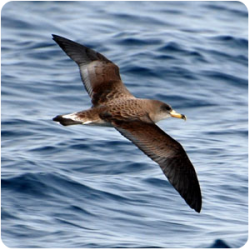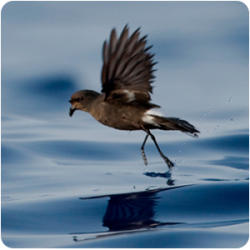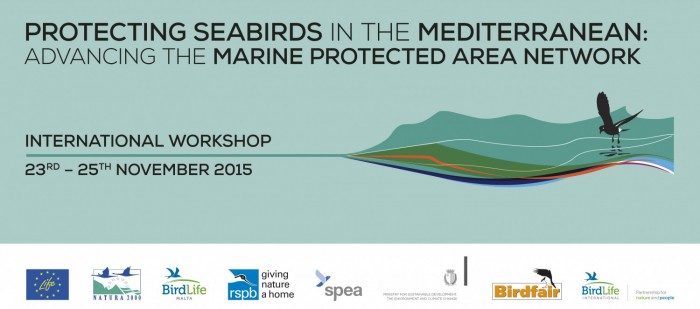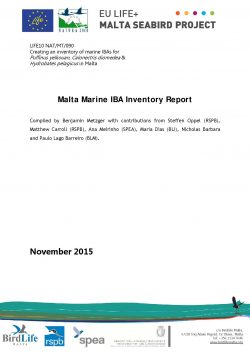The EU LIFE+ Malta Seabird Project (2011-2016) aimed to identify Marine Important Bird Areas for the three species of tubenose seabirds breeding in the Maltese Islands: the Scopoli’s Shearwater, the Yelkouan Shearwater and the European Storm-petrel. Read more on the project’s website here.
Click the icon below to view the project’s Facebook page.
About
T he EU LIFE+ Malta Seabird Project aims to create an inventory of marine Important Bird Areas (IBAs) for three seabird species; the Yelkouan Shearwater (Puffinus yelkouan), the Scopoli’s Shearwater (Calonectris diomedea), and the European Storm-petrel (Hydrobates pelagicus).
he EU LIFE+ Malta Seabird Project aims to create an inventory of marine Important Bird Areas (IBAs) for three seabird species; the Yelkouan Shearwater (Puffinus yelkouan), the Scopoli’s Shearwater (Calonectris diomedea), and the European Storm-petrel (Hydrobates pelagicus).
It is by far the largest research project focusing on the populations of these globally important seabird colonies in Malta. The project builds on the knowledge obtained by the previous LIFE Yelkouan Shearwater Project completed in 2010 and through state-of-the-art technologies aims to identify areas at sea that will be proposed for protection by the Maltese government.
The Project’s objectives are:
– To collect data on and identify the areas important for the survival of the target species within and outside Maltese territorial waters
– To evaluate this information in order to complete an inventory of Marine Important Bird Areas for Malta to present to the Maltese government
– To ensure the designation of identified marine IBA sites within Maltese territorial waters as part of Malta’s Natura 2000 network, and offshore sites as Marine Protected Areas under international agreements
– To widen the research on globally important seabird populations within the Central Mediterranean
The LIFE+ Malta Seabird Project is led by BirdLife Malta in collaboration with the Ministry for Sustainable Development, the Environment and Climate Change, the RSPB (BirdLife in the UK) and SPEA (BirdLife in Portugal). The project started in September 2011 and ran until June 2016.
LIFE+ Malta Seabird Project LIFE10 NAT/MT/090 creation for action D3, Life + page.
Malta’s Seabirds
Scopoli’s Shearwater
 This is the larger of the two shearwater species in Malta, this bird can oftenbe seen ‘shearing’ over the tops of waves. During the breeding season from end of February to October, Scopoli’s Shearwaters gather in large rafts at sea in late afternoon, before returning to their colonies at night. Malta’s population is estimated at around 4,500 pairs, equivalent to an estimated 3% of the Mediterranean breeding population. Main threats to the species in Malta are development close to the colonies, disturbance and persecution by humans, light and sound pollution and fishing by-catch. Following recent scientific research, the Scopoli’s Shearwater, previously known as the Cory’s Shearwater, is now distinguished from Calonectris borealis from the Macaronesian Islands in the North Atlantic, and the Cape Verde Shearwater Calonectris edwardsii of the Cape Verde Islands.
This is the larger of the two shearwater species in Malta, this bird can oftenbe seen ‘shearing’ over the tops of waves. During the breeding season from end of February to October, Scopoli’s Shearwaters gather in large rafts at sea in late afternoon, before returning to their colonies at night. Malta’s population is estimated at around 4,500 pairs, equivalent to an estimated 3% of the Mediterranean breeding population. Main threats to the species in Malta are development close to the colonies, disturbance and persecution by humans, light and sound pollution and fishing by-catch. Following recent scientific research, the Scopoli’s Shearwater, previously known as the Cory’s Shearwater, is now distinguished from Calonectris borealis from the Macaronesian Islands in the North Atlantic, and the Cape Verde Shearwater Calonectris edwardsii of the Cape Verde Islands.
Yelkouan Shearwater
 This medium-sized seabird flies with rapid wing beats, rarely shearing over waves. During its breeding season, from February to July, individuals may be observed resting at sea alone or in small rafts. Malta’s population is estimated to be around 1,600 – 1,800 pairs, constituting approximately 10% of the global population. The Maltese population has declined in recent years, mainly due to predation by rats, loss of breeding habitat, illegal hunting, disturbance and light and sound pollution. The IUCN classes the Yelkouan Shearwater as ‘Vulnerable.’
This medium-sized seabird flies with rapid wing beats, rarely shearing over waves. During its breeding season, from February to July, individuals may be observed resting at sea alone or in small rafts. Malta’s population is estimated to be around 1,600 – 1,800 pairs, constituting approximately 10% of the global population. The Maltese population has declined in recent years, mainly due to predation by rats, loss of breeding habitat, illegal hunting, disturbance and light and sound pollution. The IUCN classes the Yelkouan Shearwater as ‘Vulnerable.’
European Storm-petrel
 The smallest of our seabirds and hardly larger than a sparrow, storm petrelsare only occasionally observed far out at sea, approaching land only during the night, like the shearwaters. It has a typical fluttering flight and is often seen ‘hovering’ over the water’s surface as it looks for floating food. The Maltese breeding population is mainly concentrated on the small island of Filfla, which holds an estimated 5,000 – 8,000 pairs, or 50% of the Mediterranean population. If this sub-species achieves a full species designation as Hydrobates melitensis, the Filfla colony would constitute half of the entire global population.The IUCN considers the status of H. pelagicus as ‘Least concern’ although their numbers are declining.
The smallest of our seabirds and hardly larger than a sparrow, storm petrelsare only occasionally observed far out at sea, approaching land only during the night, like the shearwaters. It has a typical fluttering flight and is often seen ‘hovering’ over the water’s surface as it looks for floating food. The Maltese breeding population is mainly concentrated on the small island of Filfla, which holds an estimated 5,000 – 8,000 pairs, or 50% of the Mediterranean population. If this sub-species achieves a full species designation as Hydrobates melitensis, the Filfla colony would constitute half of the entire global population.The IUCN considers the status of H. pelagicus as ‘Least concern’ although their numbers are declining.
Research
![]() The EU LIFE+ Malta Seabird Project employs a variety of standardised research protocols and the latest tracking technology to gain a comprehensive picture of key areas of importance to the study species. Seabird colonies are monitored using a mark-recapture method, and samples are collected of regurgitates for dietary analyses.
The EU LIFE+ Malta Seabird Project employs a variety of standardised research protocols and the latest tracking technology to gain a comprehensive picture of key areas of importance to the study species. Seabird colonies are monitored using a mark-recapture method, and samples are collected of regurgitates for dietary analyses.
Between 2012 and 2013 transect counts were carried out from a boat, up to the 25 nautical mile limit of Maltese waters, to record the distribution and behaviour of the study species at sea. These data are collected following the European Seabirds at Sea (ESAS) methodology, and will contribute to global knowledge about seabirds at sea. Observers have also collected information on the habitat use of other species of birds, as well as cetaceans and turtles.
The Project uses different tracking devices to gain information about the birds’ distribution out at sea. GPS loggers are attached to the back of Yelkouan and Scopoli’s shearwaters, for a few days at a time, to record where the birds have been on their foraging trips out at sea. Small geolocators that stay with the birds for an entire year are used to find out where the birds go during their breeding season, but also during the winter and migration periods. The Project has also, for the first time in the Mediterranean, succesfully radio-tracked European Storm Petrels. Smallradio-transmitters were attached to these small seabirds, which were then tracked utilising antennae and receiver units onboard boats and small aircraft.
The project also aims to increase awareness about seabirds in Malta amongst the general public, as well as researchers and seabird experts around the world. This will be achieved by various media outputs, as well as workshops and conferences organised throughout the duration of the project.
Supporters
LIFE – www.ec.europa.eu/environment/life/
SPEA – www.spea.pt/en/
RSPB – www.rspb.org.uk
MSDEC – www.environment.gov.mt
Natura 2000 – www.ec.europa.eu/environment/nature/natura2000/
Conference
Protecting seabirds in the Mediterranean: Advancing the Marine Protected Area Network
An international workshop on Marine Important Bird Areas in Malta and the Mediterranean will be held between the 23rd – 25th November 2015 by the LIFE+ Malta Seabird Project and BirdLife International. The workshop will be a key opportunity to gather knowledge and experience on protecting seabirds across national boundaries and international waters of the Mediterranean as well as set the way forward for international collaborations in protecting our common seabird heritage.
Click here to register.
Within the Mediterranean seabirds face threats both on land and at sea, such as overfishing, by-catch, invasive predators, habitat destruction from poor planning and marine pollution. However only 4% of the Mediterranean is currently protected through the EU Natura 2000 network in Europe and the Barcelona Convention’s Specially Protected Areas of Mediterranean Importance. At a regional scale there are still many important gaps to fill in the protected area network for seabirds, particularly for sites at sea. The meeting will enable scientists, nature conservationists and policy makers to further coordinate efforts for seabird protection at a regional scale through capacity building and the sharing of specialist knowledge.
The meeting will start with the presentation of a draft inventory of Marine Important Bird Areas for seabirds in Maltese and international waters identified under the LIFE+ Malta Seabird Project. This will be followed by sessions on knowledge sharing and gap analysis for the entire Mediterranean region, identifying sites within and beyond national jurisdiction, priority areas and policy mechanisms from across the Mediterranean.
Click here to register.
Videos
Info Pack





